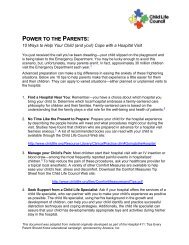My VCUG Questions - Child Life Council
My VCUG Questions - Child Life Council
My VCUG Questions - Child Life Council
You also want an ePaper? Increase the reach of your titles
YUMPU automatically turns print PDFs into web optimized ePapers that Google loves.
NOTE: Words that you see in BOLD print might need to be looked up in the dictionary<br />
we’ve included on page 9.<br />
You are scheduled to have a VOIDING CYSTOURETHROGRAM<br />
(<strong>VCUG</strong> for short). This is a test done in the RADIOLOGY<br />
DEPARTMENT of the hospital. Special pictures called X-RAYS will be<br />
taken to help your doctor know how your BLADDER is working. It also<br />
tells the doctor about the tubes that connect your bladder to your KIDNEYS.<br />
These tubes are called URETERS.<br />
We thought you should know what happens when you have a <strong>VCUG</strong>.<br />
The best way to explain this is to go step by step. If something is going to<br />
be a little different when you come in for your <strong>VCUG</strong>, the STAFF will<br />
explain. Tell them that you have read this booklet, so they know what you<br />
are expecting! As you read this with your parents write down any questions<br />
you have. Bring your questions to the hospital. We’ll be sure to answer<br />
them all before we start your <strong>VCUG</strong>.<br />
Your parent will stay with you through the whole test (unless your<br />
mother is pregnant; if this is the case, you may bring another adult to keep<br />
you company). You may bring a special toy like a teddy bear, doll, or<br />
blanket to hold during the <strong>VCUG</strong>.<br />
Some boys and girls like to wear their own shirt during the test, others<br />
like to change into a hospital top. You will need to take off your pants or<br />
1
skirt, and underwear (so they don’t get wet).<br />
When you are ready and it is your turn a TECHNOLOGIST will bring<br />
you and your parent to a room with a few big machines. These machines are<br />
just big cameras that take the special pictures! There will be a bed, some<br />
people think it looks more like a table. The cameras are connected to a TV<br />
screen so that the doctor can see the pictures as they are being taken. Let the<br />
doctor know if you would like to see your pictures on the TV screen, too!<br />
You might notice a tall pole with a bottle of clear liquid hanging at the<br />
top. The clear liquid is called CONTRAST MATERIAL. This liquid will<br />
help the x-ray pictures be clear. We’ll talk more about this later, but it<br />
works kind of like invisible ink!<br />
There will be several people in the room with you. Your parent, a nurse,<br />
a technologist, and a doctor will all be there to help you.<br />
This is a picture of the room where you will have your <strong>VCUG</strong>:<br />
2
You will be asked to climb up onto the bed (someone might need to help<br />
you). You will lie on your back. If you would like a blanket to cover<br />
yourself, just ask!<br />
Next, the nurse will need to slide a small thin tube called a CATHETER<br />
along the path (inside your body) that your URINE (pee) takes from your<br />
bladder to the outside of your body. The tube is very much like a spaghetti<br />
noodle. The opening where the nurse puts the catheter is called a<br />
URETHRA.<br />
Before the nurse can put in the catheter, they will ask girls to place their<br />
legs in the frog leg position. To do this, bend your knees and put your feet<br />
close to your bottom, then stick your knees out to the side. Boys will just<br />
need to lie flat on the bed. See the pictures below:<br />
Position for Girls Position for Boys<br />
The nurse will then clean the private area between your legs with some<br />
3
orange or pink soapy liquid. It may feel very cold and wet. This makes the<br />
area extra clean. It’s important not to touch anything below your belly<br />
button after they clean this area, until the end of the test.<br />
Putting the catheter in may be uncomfortable. The nurse will help the<br />
tube go in easier by putting some very slippery gel on the tube. When you<br />
get to the hospital ask to feel the gel to see how slippery it is! For boys, the<br />
nurse can place a little numbing gel on the tip of your penis, it helps you not<br />
feel the catheter as much. Unfortunately, this gel is not helpful for girls.<br />
Once the catheter is in place, the nurse will loosely tape the catheter to<br />
your leg so it doesn’t slip out.<br />
It will also help a lot if you can try to relax your muscles as much as<br />
possible. To help you understand, try this little experiment:<br />
Make one of your hands into a fist; squeeze your hand shut as tight as you can. Now, with<br />
your other hand, try to push a finger in-between the fingers making the fist. It’s not easy, is it!!<br />
Next, loosely hold your hand in a fist (your muscles are more relaxed this way). See if your<br />
finger fits between more easily this way.<br />
Tense hand Relaxed hand<br />
4
You might be wondering how you would be able to relax during your<br />
<strong>VCUG</strong>. We’ve listed a few ideas that might help. Practice these things,<br />
maybe while you are lying flat or in the frog leg position. See which one<br />
makes you feel more relaxed.<br />
1. Blowing bubbles: slowly take a deep breathe in, then very slowly pretend<br />
you are blowing a really big bubble. Go slowly, you don’t want the<br />
bubble to pop! You may need to pretend to blow more than one bubble<br />
while the nurse puts in the catheter.<br />
2. Singing: Practice singing some of your favorite songs…don’t leave out<br />
any of the words!<br />
3. Reading: Bring a book you really love, have Mom or Dad read it to you<br />
(or read it to them!) during the test. Other kids have said Where’s Waldo<br />
and I Spy books are very helpful.<br />
You might have your own ideas for helping yourself through this test. Let<br />
us know your ideas, we will try to do whatever we can to help. We realize<br />
this is new and different and maybe a little scary. Let us know how you are<br />
feeling. We think it’s ok to cry, too.<br />
The other thing that is important for you to do during the test is hold still<br />
when the nurse is putting the catheter in, and when the pictures are being<br />
taken. The nurse, doctor, or technologist will let you know when it’s most<br />
important for you to hold still. Sometimes your Mom, Dad or a staff person<br />
5
can help you hold still.<br />
Once the catheter is in place, it will be time for the contrast material we<br />
mentioned earlier. This is the liquid that will help the doctor see your<br />
pictures better. This fluid will go from the bottle through the tube (catheter)<br />
and into your bladder. As this happaens you might feel like you have to use<br />
the bathroom. When you don’t think you can hold another drop tell the<br />
doctor. They will then ask you to hold the contrast material in your bladder<br />
for a few more seconds while the doctor takes a couple of pictures (x-rays).<br />
Look at the two pictures below. One is a x-ray with Contrast Material<br />
one is without. Can you see how it helps the doctor see better? In the<br />
picture without the contrast material, it’s hard to see where the bladder is. In<br />
the picture with contrast, you can see the bladder (it’s labeled), and the<br />
kidneys and ureters.<br />
Without Contrast With Contrast<br />
Then, believe it or not, the doctor will ask you to let the contrast material<br />
come back out of your bladder! Right onto the table! It will seem like you<br />
6
are going to the bathroom, but really you are just letting the contrast material<br />
come out. While you are emptying your bladder, the catheter will slip out,<br />
too. The doctor or technologist will make sure there are towels under you,<br />
so that you don’t get very wet. As this happens, the doctor will take more<br />
pictures of your bladder emptying. This is how the doctor can see how your<br />
bladder works! It is important to lie very still while the pictures are being<br />
taken, so that they don’t come out blurry.<br />
After all the pictures have been taken, you’re finished!! You can wipe<br />
off any contrast material that might have spilled on you during the test (it<br />
feels like water). Then you can put your underwear and clothes back on, and<br />
go home or back to school. You should feel very proud of yourself, because<br />
YOU DID IT!<br />
Some kids tell us it tingles or feels very warm the first few times they go<br />
to the bathroom after their <strong>VCUG</strong>. The doctor says this is normal and<br />
“OK”. Don’t worry that feeling will go away soon.<br />
Created by:<br />
Teresa Fagan McDonald, CCLS<br />
California Pacific Medical Center<br />
San Francisco, CA<br />
7
<strong>My</strong> <strong>VCUG</strong> <strong>Questions</strong>:<br />
Remember to bring this with you to the hospital!<br />
8
DICTIONARY<br />
VOIDING CYSTOURETHROGRAM (<strong>VCUG</strong> for short): Pronounced<br />
voy-ding Sis-toe-you-wreath-row-gram<br />
RADIOLOGY DEPARTMENT: The place in the hospital where x-rays<br />
are taken, and where your <strong>VCUG</strong> will be done.<br />
X-RAY: A picture of the inside of your body.<br />
BLADDER: The place in your body that holds urine (pee) in-between the<br />
time you go to the bathroom.<br />
KIDNEYS: You have two kidneys. Kidneys clean waste (stuff your body<br />
doesn’t need) from inside your body and turns it into urine (pee). Your body<br />
can then get rid of the waste by going to the bathroom (peeing).<br />
URETERS: Tubes that connect your kidneys to your bladder.<br />
TECHNOLOGIST: A person that goes to school to learn how to take xrays.<br />
They will be taking your x-ray pictures.<br />
CONTRAST MATERIAL: Liquid that looks like water. When it is inside<br />
your body it helps the x-ray pictures turn out clearer, so the doctor can see<br />
them better.<br />
CATHETER: A small, thin, soft tube that is about the size of a spaghetti<br />
noodle. The doctor uses the catheter to put contrast material into your<br />
bladder.<br />
URETHRA: The opening in your body where urine (pee) comes out when<br />
you go to the bathroom.<br />
STAFF: The people that work at the hospital like the doctor, nurse and<br />
technologist.<br />
9

















